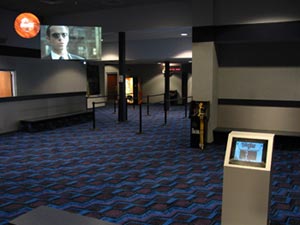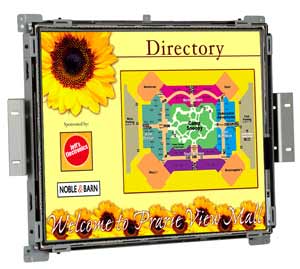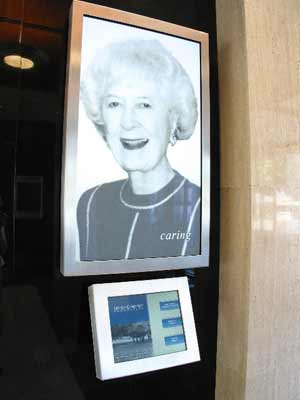Article
Seeing the future of digital displays
If you've gone shopping in recent months, you've no doubt seen them: slick, bright, colorful displays mounted on store walls, rotating ads and telling of the day's specials. And while digital signage boasts an undeniable "wow factor," the convergence of the digital display and the kiosk holds even greater promise.
March 17, 2005 by James Bickers — Editor, Networld Alliance
If you've gone shopping in recent months, you've no doubt seen them: slick, bright, colorful displays mounted on store walls, rotating ads and telling of the day's specials. And while digital signage boasts an undeniable "wow factor," the convergence of the digital display and the kiosk holds even greater promise. "Digital signage is only one piece of the marketing puzzle," said Brian Ardinger, director of business development for Lincoln, Neb.-based software developer Nanonation. "Being able to control, manage, and integrate each puzzle piece at the right time on the right device to the right person is what every deployment should be exploring." "Retailers have spent the last 15 years applying technology in the back-office for purposes of operational efficiency, inventory management, etc.," said Linda Ferguson, public relations manager for Beaverton, Ore.-based Planar Systems. "We are at the start of a large trend toward investment in storefront display-based technologies, where customer-facing display systems are critical to attract, interact, and transact with customers." The future is flat
-- Nick Daddabbo, Hand Held Products |
Before we get too deeply into the applications that digital displays make possible, let's take a moment to get a basic understanding of the technology behind them. Flat screen displays come in two main varieties, LCD and plasma. Liquid Crystal Displays work by shining a fluorescent light through liquid crystal molecules, arranged in the traditional trios of red, green and blue pixels. A grid of electrical wires selectively darkens certain pixels, regulating the amount of light that shines through. Plasma displays, on the other hand, use red, green and blue phosphors sandwiched between two pieces of glass. When electricity hits a pixel, the natural gas inside is agitated, causing it to release light. There is no backlight, so colors look vibrant and crisp from any angle. On the down side, plasma displays are heavy, fragile, and consume a lot of electricity. Price remains a primary difference between the two, with plasma units costing much more than their LCD counterparts. But as LCD technology continues to improve, prices are likely to converge in their trend downward. And even these won't remain state-of-the-art for very long: scientists are hard at work on flexible organic light-emitting diode (FOLED) technology, which could turn virtually any surface into a display - imagine wearing a shirt with display material woven into the fabric. Tech futurists tell us such ubiquitous displays are indeed somewhere on the horizon, not just the stuff of sci-fi movies. The writing on the wall
 |
Nanonation's cinema lobby installation allows viewers to select a preview on a kiosk; the preview is then shown on displays throughout the lobby. |
For now, though, the real world of today is interesting enough. Digital displays, and their synergy with the kiosk, represent an exciting new era in customer experience design. There are some especially big possibilities for the retail world. "The most exciting prospect is the ability to have displays and signage with targeted messages in multiple points throughout the store," said Nick Daddabbo, senior product manager for Hand Held Products. "Instead of one display or message, retailers can have many spots throughout the store where they can send a variety of messages. Since messages can vary by location, retailers are given the ability to target customers shopping in a particular section of the store." Area-specific marketing is not a new idea - grocery store managers have always known to put ads for this week's special near the milk and bread and other high-traffic areas. But the dynamism offered by digital signage makes it possible for much more inventive campaigns. "A customer in the furniture section can receive different messages than a customer shopping in the clothing section," Daddabbo added. "This makes the customer feel like they are in a live environment with personalized messages that are targeted toward his or her needs."
 |
A sample application of Planar Systems' LA1900 open-frame LCD display. |
According to Ferguson, the most exciting opportunities involving digital displays come from using them to augment the kiosk experience, rather than replace it. "We believe that kiosk operators should enable their clients to leverage multiple types of devices across multiple applications," she said. "By orchestrating messaging, content and applications across both kiosks and dynamic signage, these display networks can provide even more value for the kiosk operators, their clients, and the consumers who use these devices." Getting the big picture A recent installation by Nanonation shows some of the vast potential that the digital signage/kiosk marriage has to offer. Kiosks installed in a cinema lobby offer viewers the choice of multiple movie previews. Once a preview is selected, it is displayed on multiple large screens throughout the lobby.
 |
Nanonation's interactive donor wall |
Another recent project involved an "interactive donor wall" at a community foundation, which used a similar combination of kiosk and digital display to let browsers find information on donors. "I see the kiosk world converging with the digital signage world," Daddabbo said. "We're beginning to see the same types of messages and applications on personal devices as you now see on larger digital signs and screens. With the convergence, retailers have multiple ways to pass messages to customers." And, more importantly to Planar's Ferguson, they have the ability to pass those messages to specific customers, not just the audience in general. "The specific ability to attract attention with individualized messages offers the most potential for innovative uses of digital signage," she said. "We have found that consumers prefer digital communication that is targeted at their specific interests, either through narrowcasting or through customization. As software improves the ability to target specific messages based on the viewer or location, the messaging on these networks should provide even more value for consumers." What price progress? Although prices are dropping on large digital displays, they can still be prohibitively high for some applications. Making their justification even tougher is the tricky nature of determining their ROI. Did the customer who saw the "2 DVDs for $20" display make a purchase; and if so, was it because of the sign? Hard data gives way to anecdotal observation, which undoubtedly fosters reluctance. "The justification of displays will obviously be tied to the intended application," said Ferguson. "For retailers who are able to use the displays for generating incremental revenue via advertising, the model is a bit more direct. However, when the displays are used primarily to direct attention and traffic toward interactive and transactional devices, it is much more difficult to isolate the return on the displays alone." "While costs for displays and hardware are dropping every month, making ROI easier and easier to achieve, businesses need to focus on the experience they're creating and how each customer impression and interaction expands the relationship with that customer," Ardinger added. "Tying traditional digital signage with an interactive element allows businesses to immediately measure the impact of each impression and interaction." Daddabbo offers a practical suggestion for those who want reasonably firm ROI data: generate "soft ROI metrics" by running two marketing campaigns, one with digital displays, and one without. "Companies can see soft ROI by undergoing a side-by-side analysis that measures the success and results of past marketing campaigns which did not take advantage of digital signage against the results of similar marketing campaigns that make use of the new displays," he said. For operators with long-range vision, Ferguson said it is important to look beyond individual balance sheet line-items and see how digital displays can have an impact on the entire kiosk experience, even if their profitability is not immediately measurable. "The focus of the investment justification must shift to a more holistic view of the entire project, including kiosks, digital displays, software to manage a display network and the applications that run on that network," she said. "In this way, digital displays become just part of the overall solution that helps generate revenue through advertising or sales, while decreasing the cost of customer service."










